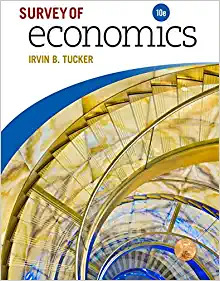



Helpmeanswerthefollowingquestions,thanks:
Answer all.,
Argentina and New Zealand each produce wheat and mutton under conditions of perfect competition, as shown on the accompanying production possibilities curves. Assume that there is no trade between the two countries and that Argentina is now producing at point A and New Zealand at point C
. a.What is the opportunity cost of producing each good in Argentina?
b.What is the opportunity cost of producing each good in New Zealand?
Exercise 4.5 Suppose you are given the following data on incomes and expenditures for the econ- omy of Westland, in current prices for factors of production and outputs. Consumption expenditures 2,500 Employment compensation 2,800 Government expenditure 800 Net indirect taxes 150 Exports 1,200 Gross corporate surplus and mixed income 1,050 Investment expenditure 600 Imports 1,100 (a) What is the value of nominal GDP measured by expenditures? (b) What is net domestic income? (c) What is the value of nominal GDP measured by the income approach? Exercise 4.6 Suppose GDP is $2,000, consumption expenditure is $1,700, government expenditure is $50, and net exports are $40. (a) What is business investment expenditure? (b) If exports are $350, what are imports? (c) In this example, net exports are positive. Could they be negative? Exercise 4.7 Consider the following information about a hypothetical economy: Year Nominal GDP GDP deflator Population (billions $) (2000 = 100) (millions $) 2012 750 104.0 25.0 2013 825 112.0 30.0 (a) Calculate the growth (percentage change) in nominal GDP from 2012 to 2013. Exercises for Chapter 4 = 101 (b) What was real GDP in 2012 and 2013? How much did real GDP grow? (c) If changes in the standard of living can be measured by changes in real per capita GDP, did growth in nominal and real GDP raise the standard of living in this economy from 2012 to 2013? (d) Explain the reasons for the change in standard of living that you have found.2. Understanding preference assumptions Complete the following table by identifying which assumption each given scenario references. (Note: The scenario might be an example or a violation of the assumption.) Assumptions Scenario Complete Transitive Tastes Tastes Monotonicity Convexity Continuity Musashi usually buys three pounds of ham and two pounds of turkey each week at the grocery store. When the grocery store had only 1.99 O O O O O pounds of turkey available, he didn't feel that worse off. Kyoko would rather own all black socks or all white socks, rather than 50% of each, because it stresses her out to keep her dresser drawers O O O O O organized. Jacques likes apples more than bananas and bananas more than grapefruit. When faced with a choice between apples and grapefruit, he O O O O O chooses apples as expected. Rina is shopping at her local department store, and she claims she is unable to compare a pair of jeans with a pair of slacks, even though she O O O O O must pick one to wear tonight. Your mum would prefer to have three times as many pots and pans as she currently has. O O O O O20. The following statements compare and contrast explicit collusion and tacit collusion. Which of these statements are correct? (a) Explicit collusion involves a conspiracy among firms to raise prices, while tacit collusion arises when firms are able to coordinate on higher prices without explicit communication or conspiracy. (b) Economically, explicit and tacit collusion have similar consequences: both lead to higher prices, lower consumer surplus, and lower total surplus. (c) Legally, explicit collusion and tacit collusion are regulated differently: ex- plicit collusion is always illegal, while antitrust policy towards tacit collu- sion principally focuses on practices which facilitate price coordination. (d) All three statements above are correct.17. Which of the following was NOT a notable feature of interaction among GE and Westinghouse in the heavy equipment industry during the 1950s to 1970s? (a) Explicit collusion on secret bid auctions, using "phases of the moon" to coordinate which member of the cartel was designated to win the contract. (b) Large fines following detection of "phases of the moon" bidding, leading several firms to exit. (c) Tacit collusion facilitated by reciprocal commitments to price transparency, leading to high and stable prices. (d) Commitment to free and vigorous market competition. 18. It is observed that Danish concrete prices increased substantially following a regulation requiring all concrete firms to disclose their prices publicly. Assum- ing no other relevant features of the industry changed, what model of conduct provides the best explanation for this outcome? (a) Bertrand competition in which price transparency allowed consumers to shop more aggressively on price. (b) Collusive pricing with anticipated demand shocks, in which firms cut prices during periods of high demand to minimize temptation to cheat. (c) Collusive pricing with uncertain demand, in which price transparency re- quirements eliminated the possibility of secret price cuts. 19. What was the main factor driving price wars in the early years of the Joint Executive Committee railway cartel? (a) Firms anticipated that demand would be higher in the winter than in the summer, due to less competition from shipping. They responded by cutting prices in the winter, to minimize temptation to cheat. (b) The cartel was unable to adjust output quotas appropriately in the face of entry by new firms. Price wars ensued. (c) Antitrust enforcement: Facing potential action by the Department of Jus- tice, the cartel members abandoned their attempts to collude and began aggressively competing on price. (d) Firms were unable to distinguish periods of unexpected low demand from secret price cuts by rivals. They responded to periods of low demand with temporary price wars














